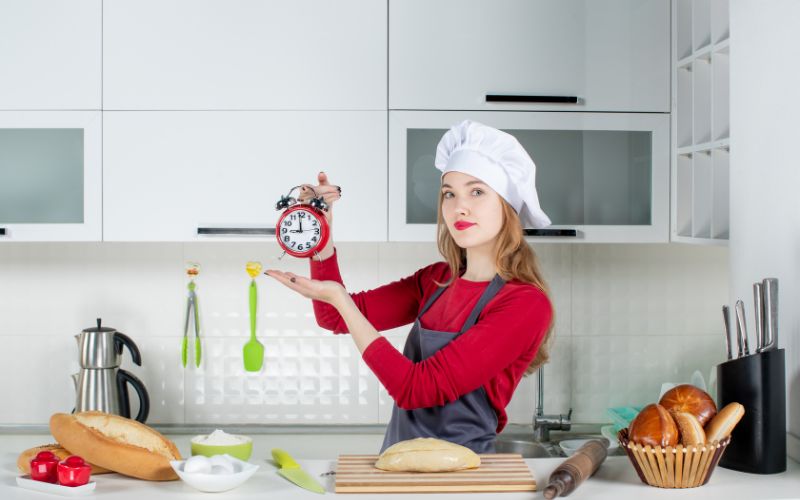In the fast-paced environment of the restaurant industry, reducing cooking time is paramount to achieving success. Efficient kitchen operations are critical as they directly impact a restaurant’s ability to serve more customers quickly without compromising food quality. By minimising cooking time, restaurants can significantly increase their efficiency, enabling them to handle a higher volume of orders during peak hours. This efficiency not only helps manage costs but also plays a vital role in enhancing customer satisfaction. Customers today expect prompt service, and a shorter wait time for their meals leads to a better dining experience, fostering repeat business and positive word-of-mouth. Moreover, improved efficiency and customer satisfaction contribute to higher turnover rates, allowing restaurants to serve more patrons in a given timeframe and thereby boosting revenue. In a competitive market, these benefits collectively help restaurants to stay ahead, maintaining a steady flow of happy customers and ensuring sustained growth.
1. Streamline Kitchen Layout
- Optimise Kitchen Design for Smooth Workflow
A well-organised kitchen layout is fundamental for reducing cooking time. Designing a kitchen for a smooth workflow involves strategically placing equipment and workstations to minimise unnecessary movement. This ensures that chefs and kitchen staff can move efficiently between different areas, reducing the time spent walking back and forth.
- Minimise Distance Between Stations
Reducing the distance between stations is another critical factor. For instance, placing prep areas close to cooking stations, and ensuring that storage for ingredients and utensils is within arm’s reach, can significantly cut down on the time taken to complete tasks. This setup helps in creating a more fluid and rapid workflow.
- Use Ergonomic Setups to Reduce Movement and Time
Ergonomic setups play a crucial role in streamlining operations. By designing workstations that allow staff to perform tasks with minimal physical strain and movement, the kitchen can operate more efficiently. This involves adjusting the height of countertops, ensuring proper lighting, and organising tools and ingredients in a manner that they are easily accessible, thereby saving valuable time.
2. Prep Work and Organisation
- Emphasise Thorough Prep Work Before Service
Thorough prep work before service is essential for reducing cooking time during peak hours. This includes washing, cutting, and measuring ingredients in advance. Having everything ready to go can greatly reduce the time it takes to prepare dishes during service.
- Implement a System for Organised Ingredient Storage
An organised storage system for ingredients is crucial. This logically involves labelling and categorising ingredients, ensuring that everything has its place and is easy to find. This not only speeds up the cooking process but also reduces the likelihood of mistakes.
- Use Pre-Portioned and Pre-Prepped Ingredients When Possible
Using pre-portioned and pre-prepped ingredients can save a significant amount of time. By portioning out ingredients in advance, chefs can quickly grab what they need without having to measure during the cooking process. Pre-prepped items, such as chopped vegetables or marinated meats, further streamline the cooking process.
3. Efficient Cooking Techniques
- Train Staff in High-Speed Cooking Methods
Training staff in high-speed cooking methods, such as stir-frying and sautéing, can drastically reduce cooking times. These techniques are designed for quick cooking and can produce high-quality dishes in a fraction of the time.
- Utilise Batch Cooking for Popular Items
Batch cooking is another effective technique. By preparing large quantities of popular items in advance, kitchens can quickly serve these dishes without the need for additional cooking time. This is particularly useful during busy periods.
- Incorporate Multi-Tasking Techniques
Multi-tasking techniques can further enhance efficiency. For example, while one dish is simmering, chefs can be prepping ingredients for the next dish. This ensures that no time is wasted and multiple tasks are being completed simultaneously.
4. Advanced Kitchen Equipment
- Invest in High-Efficiency Appliances
Investing in high-efficiency appliances, such as convection ovens and rapid cookers, can significantly reduce cooking times. These appliances are designed to cook food faster and more evenly, improving both speed and quality.
- Use Modern Tools Like Food Processors and Slicers
Modern kitchen tools, such as food processors and slicers, can also save time. These tools can quickly chop, slice, and puree ingredients, reducing the time it takes to prepare them manually.
- Regular Maintenance of Equipment to Ensure Optimal Performance
Regular maintenance of kitchen equipment is essential to ensure they are operating at their best. Well-maintained equipment is more efficient and less likely to break down, which can save time and prevent disruptions in the kitchen.
5. Menu Simplification
- Streamline the Menu to Include Dishes with Shorter Cooking Times
Simplifying the menu to focus on dishes with shorter cooking times can help reduce overall kitchen time. This doesn’t mean sacrificing variety or quality, but rather choosing dishes that can be prepared quickly and efficiently.
- Focus on Cross-Utilising Ingredients to Reduce Prep Complexity
Cross-utilising ingredients can also help streamline operations. By using the same ingredients in multiple dishes, prep work is reduced, and cooking times can be minimised.
- Highlight Quick-Cook Options for Busy Periods
Highlighting quick-cook options on the menu during busy periods can help manage kitchen load. These options can be promoted to customers who are in a hurry, ensuring they receive their meals quickly.
6. Staff Training and Coordination
Regular training sessions are essential to keep kitchen staff up-to-date on time-saving techniques. Continuous learning and improvement help staff work more efficiently and stay prepared for busy periods.
Strong communication and teamwork are vital for a smooth kitchen operation. Ensuring that all staff members are on the same page and can work together seamlessly helps in reducing cooking times and avoiding mistakes.
Assigning specific roles and stations to kitchen staff helps to avoid overlap and confusion. Clear responsibilities ensure that everyone knows what they need to do, which streamlines operations and reduces the time taken to complete tasks.
7. Time Management Techniques
Implement Time tracking and management systems that can help monitor kitchen operations and identify areas for improvement. By tracking how long tasks take, restaurants can make adjustments to improve efficiency.
Checklists and timers are simple yet effective tools for managing time in the kitchen. They ensure that tasks are completed on schedule and help maintain consistency in cooking times.
Regular reviews of kitchen operations can identify bottlenecks and areas for improvement. Making adjustments based on these reviews can help improve speed and efficiency over time.
8. Use of Technology
- Implement Kitchen Display Systems (KDS) for Efficient Order Management
Kitchen display systems (KDS) can streamline order management. These systems provide a clear and organised way to manage orders, reducing confusion and speeding up the cooking process.
- Utilise Inventory Management Software to Streamline Restocking
Inventory management software helps streamline restocking and ensures that ingredients are always available. This prevents delays caused by running out of essential items.
- Explore Apps and Tools That Aid in Recipe Management and Scheduling
There are many apps and tools available that can aid in recipe management and scheduling. These tools can help keep the kitchen organised, ensuring that recipes are followed precisely and that tasks are completed on time.
Read More: The Power of Planning in a Busy Restaurant Environment
Conclusion:
Reducing cooking time in restaurant kitchens is essential for boosting efficiency, enhancing customer satisfaction, and increasing overall turnover. By implementing strategies such as streamlining kitchen layouts, emphasising thorough prep work, utilising efficient cooking techniques, investing in advanced equipment, simplifying menus, training staff effectively, managing time wisely, and leveraging technology, restaurants can create a more productive and profitable kitchen environment. These practices not only speed up operations but also contribute to a better dining experience for customers, fostering loyalty and repeat business.
To achieve these benefits, restaurant managers and owners should start by assessing their current kitchen operations and identifying areas for improvement. By taking proactive steps today, you can transform your kitchen into a powerhouse of efficiency and delight your customers with faster, high-quality service.










